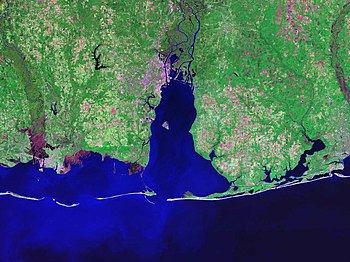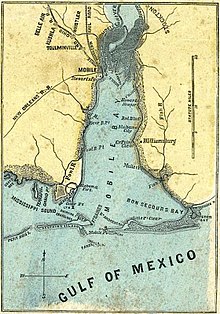Mobile Bay

Mobile Bay (
Mobile Bay is 413 square miles (1,070 km2) in area. It is 31 miles (50 km) long by a maximum width of 24 miles (39 km).[1] The deepest areas of the bay are located within the shipping channel, sometimes in excess of 75 feet (23 m) deep, but the average depth of the bay is 10 feet (3 m).[1]
History
Long occupied by cultures of indigenous peoples, this area was still under the chiefs of Mississippian culture at the time of Hernando de Soto's exploration.
The recorded history of Mobile Bay begins about 1500, when Spanish explorers were sailing into the area. On early maps, the bay was named as Bahía del Espíritu Santo (Bay of the Holy Spirit). The area was explored in more detail in 1516 by
European exploration into the region

Hernando de Soto explored the area of Mobile Bay and beyond in 1540, finding the area inhabited by indigenous
Although Spain's presence in the area had been sporadic, in 1702
Role in wars
During the
Natural disasters in the area
The city has endured several devastating hurricanes in its history, the most recent being Hurricane Frederic in 1979 and Hurricane Katrina in 2005. Areas of low elevation, including the downtown business district, have been flooded repeatedly in hurricanes. However, much of the city is at an elevation exceeding 200 feet (61 m) above sea level, which is unusually high for the Gulf and Atlantic coasts.
On September 13, 1979,
Shoreline towns
The city of
The head of the bay is crossed by two major thoroughfares,
See also
- Gulf Islands National Seashore - offshore islands, includes nearby states.
- Gaillard Island
- Mobile-Tensaw River Delta
References
- ^ a b c "Estuarium Exhibits: Mobile Bay". Dauphin Island Sea Lab. Archived from the original on 2008-02-22. Retrieved 2008-02-08.
- ^ ISBN 0-8173-1065-7
- ^ "The Old Mobile Project Newsletter" (PDF). University of South Alabama Center for Archaeological Studies. Archived (PDF) from the original on 2022-10-09. Retrieved 2007-11-19.
- ^ "Historic Fort Conde". MuseumOfMobile.com. Retrieved 2007-05-06.
- ISBN 978-0-8071-3274-6.
- ^ Hyatt, Wendy. "Fort Morgan Historical Site Information". Retrieved 30 August 2022.
- ^ "History". Rivers of Alabama: Mobile Bay. Archived from the original on 2008-03-12. Retrieved 2008-02-05.
External links
- Mobile Baykeeper - local Waterkeeper Alliance group
- . . 1914.

